Going for Gold: Elana Meyers Taylor & Nico Taylor
January 10th, 2023 by Global Down Syndrome Foundation
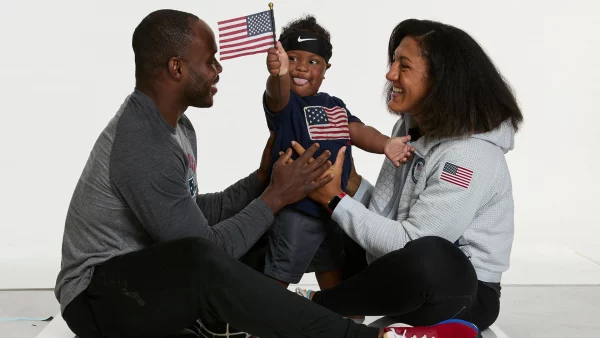
From Down Syndrome World Issue 3, 2022
ELANA MEYERS TAYLOR, has collected numerous inspiring accolades throughout her life. She is perhaps most known for making history in the 2022 Beijing Olympics, receiving her fifth medal (she has three silver and two bronze) in bobsledding. Taylor is the most decorated black Olympic winter sports athlete and the most decorated U.S. Olympic bobsledder of all time. This is an impressive feat for anyone to accomplish, and Elana did it all while raising her beautiful son, Nico, who has Down syndrome.
Like most children, Elana had big dreams for her future at a young age. Since seeing the 1996 Summer Olympic Games in her hometown of Atlanta, Georgia, she knew she wanted to be the one standing on the podium one day. A renaissance athlete, she participated in sports throughout her childhood and well into adulthood. As a kid, she played softball, basketball, track & field, and soccer, all with the intention of becoming an Olympic athlete one day. She went on to play collegiate softball at George Washington University and played professionally after college as well. With all this work building toward her dream of becoming an Olympian, Elana felt immense pressure during her tryout for the US Olympic Softball team. “I put the weight of the world on me and just completely choked.” Taylor stated, “I just couldn’t handle the pressure and thought it was going to be my only chance to live my dream.” This setback allowed her to set her sights on a new sport to carry her to the Olympics.
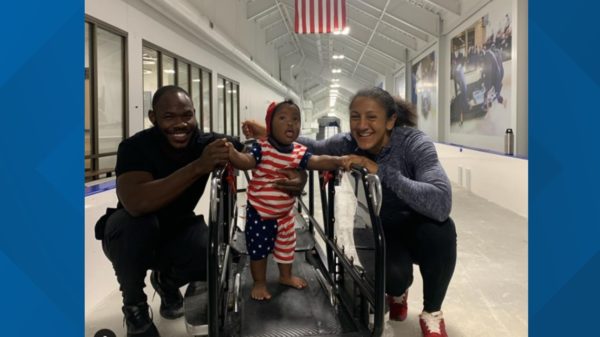
Taylor’s parents, Eddie and Janet Meyers, suggested she check out bobsledding as an option, and even though she knew nothing about the sport, she decided to give it a shot. Her natural athleticism propelled her through the first round of trials where she could then hone her technical skills to make her a strong competitor in bobsledding. After competing in the U.S. National Team trials and World Cup tour, she qualified to race in the World Championship race within her first year as a brakeman.
Her triumph in the World Championship races as a brakeman allowed her to start racing in the front seat as a driver, and from there she began her legacy as a bobsled icon, making her debut on the U.S. bobsled team at the 2010 Vancouver Olympics. She has continued to compete in the two-woman and Monobob races at the Olympic level, and even qualified to race on the men’s four-man bobsled team!
Elana’s story of success in making her way to the Olympics and earning such honorable titles along the way is admirable on its own, but her work does not stop there. Elana is a devoted advocate for women of color competing in the Olympics and uses her 5-medal status to get her foot in the door and initiate change at a higher level. “Other people like to scream and shout and, you know, take to social media and stuff like that. That’s not really my cup of tea.” She prefers to do her work behind the scenes by having these difficult conversations about equity for women of color in sports with the higher-ups in the Olympic committees, pushing for that positive change. It is clear, that Elana has a passion for advocacy and creating space for marginalized groups to excel, and this passion grew even stronger with the birth of her first son, Nico.
Becoming a Mother and an Olympic Athlete
Amid the rise of her Olympic career, Taylor and her husband, fellow Team USA bobsledder Nicholas Taylor, became pregnant with their first child, Nico, who was born at the start of the COVID-19 pandemic in 2020. Following her silver medal-winning run at the 2018 Winter Olympic Games in Pyeongchang, Taylor was unsure if she wanted to compete in another Olympics. She was already a 3-time medal winner and was feeling content with the progress she has already made in her bobsled career. “You can only be driven so much by a gold medal,” stated Taylor. However, the news of her pregnancy sparked a new kind of motivation in Taylor that she did not quite expect. Competing at the Olympic level while navigating pregnancy and becoming a first-time parent was a new challenge that she was determined to take on.
Elana and her husband continued training throughout her pregnancy, adapting a garage in their apartment building into a home gym to get their training schedule back on track. Less than 6 months after Nico was born, Elana was already working towards making the U.S. National Team and eventually competing in the 2022 Winter Olympics. Nico was along for the ride every step of the way, traveling to Lake Placid with his mother to train and cheering her on from the sidelines at competitions across the globe.
Wherever Elana was, Nico went too. She wanted to show the world that just because she is now a mother, let alone a mother of a child who is differently-abled, she is still a force to be reckoned with in her sport. Her new-found motivation from her son and desire to prove to the world that motherhood does not have to thwart a lifetime of progress drove her to the 2022 Winter Olympics in Beijing, where she earned a silver medal in the women’s Monobob event and bronze in the women’s 2-person bobsled. Now, as a 5-time medalist in bobsledding, her goal is to use her status to uplift and advocate for other women in sports—especially women of color—to fight for equality and serve as a beacon of hope that change is possible.
Taylor’s Experience Raising a Child with Down Syndrome
For most people, having a child at the start of a global pandemic, receiving the Down syndrome and significant hearing loss diagnoses, and a tiresome, eight-day extended stay in the NICU, would be overwhelming. But Elana and Nicholas Taylor did not falter for a second. The Taylors’ athlete mindset helped them make a plan of action to provide Nico the best care possible while still being able to train for and compete in the upcoming 2022 Olympics.
Taylor brings Nico along with her to all her events to show that children with Down syndrome can live normal, happy lives, and more importantly, be an example to her son that you can go out and achieve your goals regardless of what the world is telling you. “We were like, okay, now the rest of the world’s going to tell him he can’t achieve stuff,” Taylor stated. “The rest of the world’s going to tell him ‘No’. Just like they tell female athletes ‘No’. Or they tell moms ‘No, you can’t achieve certain things and you can’t do certain things.’ I want to be there for him and make sure he knows the opposite is true.” Taylor never let skepticism steer her away from accomplishing her goals, and now hopes to pass on that unwavering mindset to Nico.
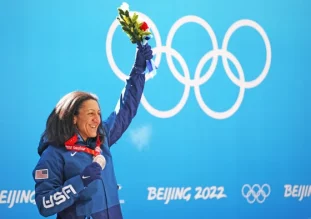
Many people formulate incorrect assumptions about individuals with Down syndrome based on outdated stereotypes. Due to advances in research, medical care, and inclusion, an increasing number of adults with Down syndrome in the U.S. are going taking post-secondary classes or going to college, getting jobs, playing sports, working, getting married and living semi-independent or independent lives.
As a mother, Taylor hopes that her son can see the obstacles she has overcome in her career to inspire him to chase his dreams without hesitation. “If I could advocate for anything to the world, it is to show that our kids have worth, that they can be important and valuable members of our society, and that the people with Down syndrome in our lives should have the same respect and opportunities as anyone else.”
Taylor’s Advice to Families of Individuals with Down Syndrome: “You Are Much Stronger Than You Think”
Parents of children with Down syndrome have some extra hurdles to navigate throughout their child’s life, but these are not infeasible challenges. Therapy, doctor visits, and assisting with daily living tasks can be daunting responsibilities but are not unmanageable compared to the needs of a typical child. Taylor encourages families who either currently have or are about to welcome a child with Down syndrome into their lives to look past the negativity that is so often thrown at them from the outside world and to know that living with a person with Down syndrome is a gift in itself. “I think all of us have that ability inside of us,” Taylor mentions, “just most of us don’t realize we do”.
Taylor and her husband go above and beyond to provide the best for Nico, and when faced with challenges that seem impossible or overwhelming, they are reminded that Nico is a child like any other, and their job as parents is to simply love and support him unconditionally. “Just trust your own abilities and know that you are much stronger than you think.” The Taylors’ unwavering love for Nico has helped them face these new circumstances head-on and accept that while their situation is not a typical one, they can still achieve their goals as a family. Much like Taylor’s unexpected path to the Olympics—averting her original plans of playing softball and taking on a completely new sport—her experience raising Nico has brought her and her family more gratification and joy than they ever could have imagined.
Advocating for a Brighter Future for those with Down Syndrome
Great strides have been made to reverse the harmful, outdated assumptions about people with Down syndrome in society, but there is still a lot of work to do. Many health and medical concerns associated with Down syndrome still do not have adequate research and funding dedicated to them. At GLOBAL, the mission is to significantly improve the lives of people with Down syndrome through research, medical care, education, and advocacy. In 2021, Elana Myers Taylor attended the GLOBAL AcceptAbility Gala in Washington DC and inspired the audience with her work on inclusion and with her powerful speech made with Nico in her arms.
She is clearly someone who leads by example and works to open doors for individuals who are differently-abled in their communities. At the event Taylor announced that she was proud to be an official GLOBAL International Spokesperson joining the ranks of Quincy Jones, Jamie Foxx, John C. McGinley, Frank Stephens, Kyra Phillips, Beverly Johnson, and Amanda Booth. As an International Spokesperson and member of GLOBAL’s Champion Advisory Board, Taylor will work every year to advocate in Washington, DC, her hometown of Atlanta, and around the world.
“I’m so honored and excited to be part of an organization that in a very short time has succeeded in advocating for increased federal Down syndrome research funds,” Taylor says. “We need to have both sides of the aisle advocating for our kids and to come up with a plan to address lifespan and health disparities for black people with Down syndrome as well. Our kids deserve equity, respect, inclusion, and the right to live safe, happy and productive lives.”
Clearly the Down syndrome community has a formidable ally and a new leader in Taylor who understands how to work hard and create real change.
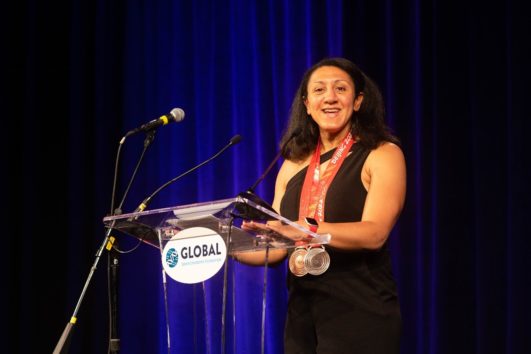
Like this article? Join Global Down Syndrome Foundation’s Membership program today to receive 4 issues of the quarterly award-winning publication, plus access to 4 seasonal educational Webinar Series, and eligibility to apply for Global’s Employment and Educational Grants.
Register today at downsyndromeworld.org!
Collettey’s Cookies: The Taste of Sweet Success
October 28th, 2022 by Global Down Syndrome Foundation
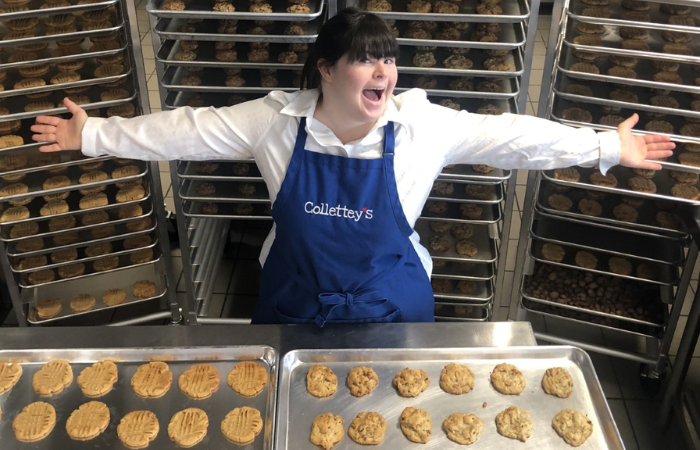
From Down Syndrome WorldTM 2022 Issue 2 of 4, written by Emmy Award winner Hanna Atkinson
The Taste of Sweet Success
 This article was published in the award-winning Down Syndrome World™ magazine. Become a member to read all the articles and get future issues delivered to your door!
This article was published in the award-winning Down Syndrome World™ magazine. Become a member to read all the articles and get future issues delivered to your door! What does success look like?
Let me introduce Collette Divitto, the talented chef and owner of the business she named after her skills, Collettey’s Cookies. Ironically, her idea for the business came after many job interviews and rejection letters. “I was tired of waiting on someone else to make my dreams happen, so I decided I’d make them happen for myself,” says the outstanding 31-year-old entrepreneur.
Collette has always loved baking. In fact, she started creating her masterpieces at the young age of four. Through the years, she tweaked the recipes based on her family’s feedback until eventually she had it down to a science. As her cookies were gaining popularity amongst friends and family, Collette decided to try to sell them for the first time.
When she was in high school, Collette would bake healthy breakfast cookies and sell them in front of local gyms and stores. Her after school gig was small, but successful. “I’ve always been a hard worker, but when I was making my own money working hard, that felt really cool. I wanted to explore that more,” says Collette, who then closed down her cookie business in pursuit of college. She completed a 3-year program at Clemson University with a concentration on food and nutrition. While studying what she’s passionate about, she made sure to make time for all the other excitement that college life had to offer including making new friends, shopping, enjoying apartment life, and going to sports games and concerts, job responsibilities and bills. Collette’s college experience empowered her to feel confident in her independence – she was managing her own school and work schedule, paying her own bills, living on her own, and not relying on her parents.
Eager to apply her expanded culinary knowledge, Collette was disappointed when the traditional post-college job market did not reward her talents and experience with a great job. With the support of her mother, Rosemary, Collette started her own business, Collettey’s Cookies.
“I told Collette that because she’s an adult now, this business venture would need to be more sophisticated than her high school gig,” says Rosemary. “It was important for Collette to learn the whole business ownership process ,including registering the business, doing invoices, and lining up suppliers. She did a great job compiling research and figuring out everything that needed to be done.” And no, Rosemary did not need to teach Collette how to bake – that one is Collette’s specialty!
Running the Kitchen
As a business owner, Collette has a really busy schedule. She runs team meetings daily, where she outlines the team production goals and discusses each employee’s responsibilities. Collette is an expert at cookie preparation; her method ensures every batch of cookies turn out perfectly every time. Collette is passionate about providing thorough training to her employees and she loves giving cooking demonstrations. But the crew makes sure to have fun too! There’s a lot of laughing and smiling happening in the kitchen as they work.”
“I try to create a work environment that helps employees succeed. I encourage them to work hard and be happy.”
A key ingredient of Collette’s managerial style is providing strong support for her team. She is proud that her business hires people with special abilities and promotes the positivity of inclusion. Collette fights for these ideas, including traveling to Washington, D.C. to participate in government advocacy for fair employment policies like proper wages.
Collette welcomes her peers to join with her and encourages them to develop their personal skills. She developed Collettey’s Leadership Program that offers educational workshops on topics ranging from success in school to becoming an entrepreneur.
“Collete is a strong leader because she shares her real experiences with failure and success in hopes that her lessons will help others learn and grow,” says Rosemary. “It’s awesome to watch how people take notice when she begins to talk. They trust her insight, knowing her intentions are good and that she is seeking everyone’s best interest.”
Collette writes about her personal and professional struggles and how she dealt with them in her new book, “Collette in Kindergarten” which recently hit the shelves. The book is the first for an intended series of books that provide her unique perception growing up as a person with Down syndrome. Collette hopes each book will be helpful and positive. Her skills and determination were noticed and are spotlighted in the docuseries called “Born for Business” streaming on Peacock and CRAVE.
Despite Collette’s incredibly packed work schedule, she tries to make time for other hobbies she enjoys like travelling, swimming, tennis, watching movies and sports and evenings out with friends. Collette prioritizes time with family including her sister, Blake Ashley, and her brother, Steele. Rosemary says that they are a close-knit family and are very proud of Collette. When asked what Collette’s greatest strength is, Rosemary quickly said “confidence.”
To which Collette responded with this powerful statement: “No matter who you are, you can make a difference in the world.” Collette is a visionary using her success to impact lives. Now that is truly sweet success.
To learn more about this organization, visit https://colletteys.com/
Like this article? Join Global Down Syndrome Foundation’s Membership program today to receive 4 issues of the quarterly award-winning publication, plus access to 4 seasonal educational Webinar Series, and eligibility to apply for GLOBAL’s Grants.
Register today at downsyndromeworld.org!
Researcher Profile: Keith Smith
December 27th, 2021 by admin
Since childhood, Keith Smith has been curious about how “life” works, including why people are born different or get sick with diseases like cancer or Alzheimer’s.
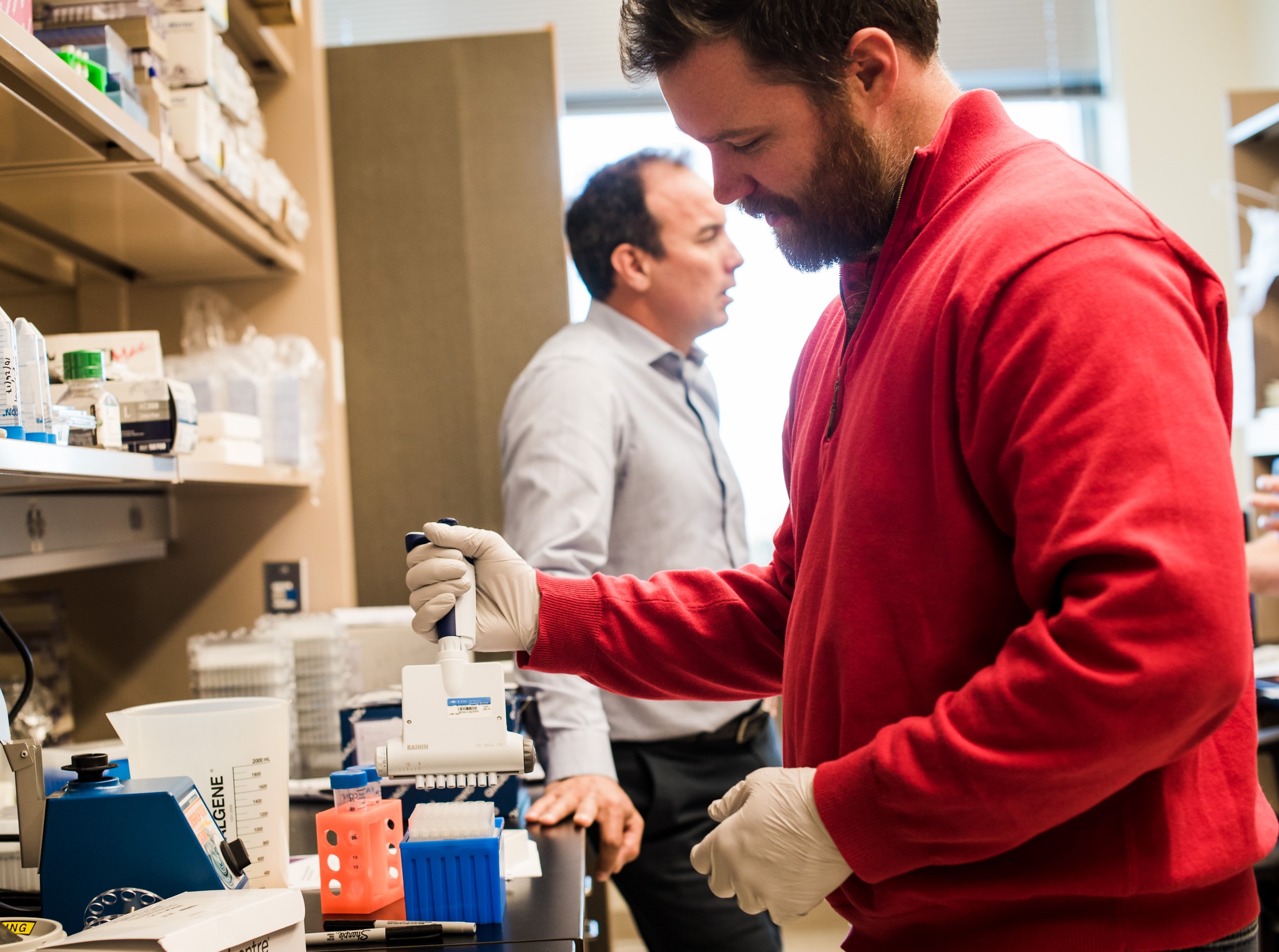
Today, as the Laboratory Sciences Program Manager at the Linda Crnic Institute for Down Syndrome, Keith gets to feed his curiosity by overseeing the day-to-day operations of Dr. Joaquín Espinosa’s clinical research on medical conditions that co-occur with Down syndrome. This includes the management of the game-changing, GLOBAL funded, Crnic Institute Human Trisome ProjectTM (HTP).
The HTP is one of the world’s largest studies aimed at understanding co-occurring diseases and conditions in people with Down syndrome and is made up of thousands of donated biological samples. Keith manages these samples and HTP Biobank collaborations with over 30 research teams across the University of Colorado school systems and around the world.
Keith’s career in Down syndrome research is motivated by a personal connection. His older brother, Randy, 39, happens to have Down syndrome and has had a profound impact on Keith’s life in more ways than one.
“The work that I do at the Crnic Institute is rooted in love and is near and dear to my heart,” says Keith. “Randy has inspired me to be humble, kind, patient and resilient…When I need motivation, I think about Randy to remind myself to not take anything for granted and take full advantage of all opportunities.”
The HTP is proving to be a powerful discovery accelerator as the Crnic Institute team looks at biological samples and asks questions like – do the 60+% of people with Down syndrome who have sleep apnea also all have some other condition? Or are they all seemingly protected from some other condition?
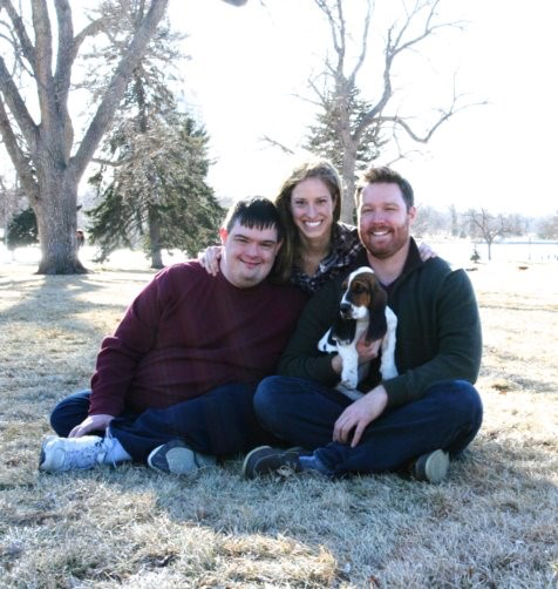
Using data from the HTP, in 2016 the Crnic Institute published its groundbreaking study that showed Down syndrome can be categorized as an immune system disorder based on overproduction of the interferon immune system response.
Keith’s wife, Kate Waugh, PhD, is an immunologist and a researcher at the Crnic Institute who is also making important contributions to this body of work. It is having a deep impact on not only on the Crnic Institute research, but on dozens of labs across the world focusing on how to improve the lives of people with Down syndrome based on this important discovery. Kate’s dedication is deeply rooted in her relationship with Keith and Randy. She half jokes that she fell in love with Randy first and then warmed up to Keith.
“I have my best friend everyday ‘in the trenches,’” says Keith. “We’re able to somewhat disconnect when we are away from the lab, having two little girls at home – Lillian and Anna – but Randy and Down syndrome research is nearly always on our minds.”
Keith and Kate often express how they are “forever grateful” for the support and funding from the Global Down Syndrome Foundation. “We are so inspired by the generosity of Anna and John Sie, and by Michelle’s tireless dedication to her daughter and everyone with Down syndrome,” says Kate.
Keith agrees, “Their vision of a world-class academic home for Down syndrome research created the Crnic Institute and paved the way for better medical care for people with Down syndrome including Randy.”
“How I gravitated towards Down syndrome was something of magic,” continues Keith. “I believe things happen for a reason, and there is a reason I am here. To truly make a difference in the lives of people with Down syndrome, and we might just make a difference in cancer research, Alzheimer’s, and autoimmunity along the way!”
Keith recently received the 2020-2021 University Research Awards for Outstanding Senior PRA and was recognized for his work during the COVID-19 Pandemic. Congratulations to Keith Smith! GLOBAL is proud and grateful for his many contributions to research benefitting our loved ones with Down syndrome.
A Holiday Message from GLOBAL President & CEO
Michelle Sie Whitten
December 22nd, 2021 by admin

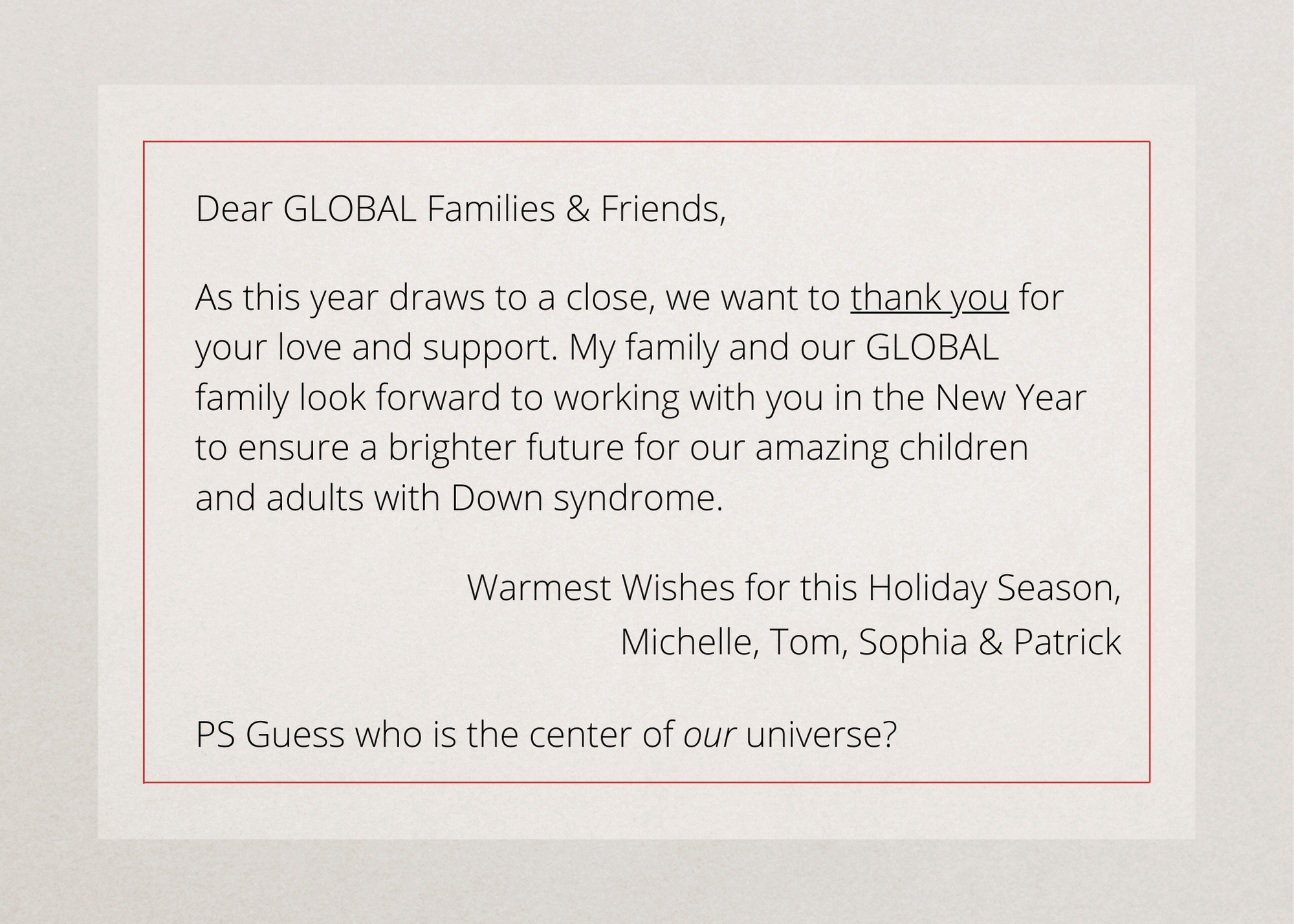
Building More Than Muscle
October 13th, 2021 by admin
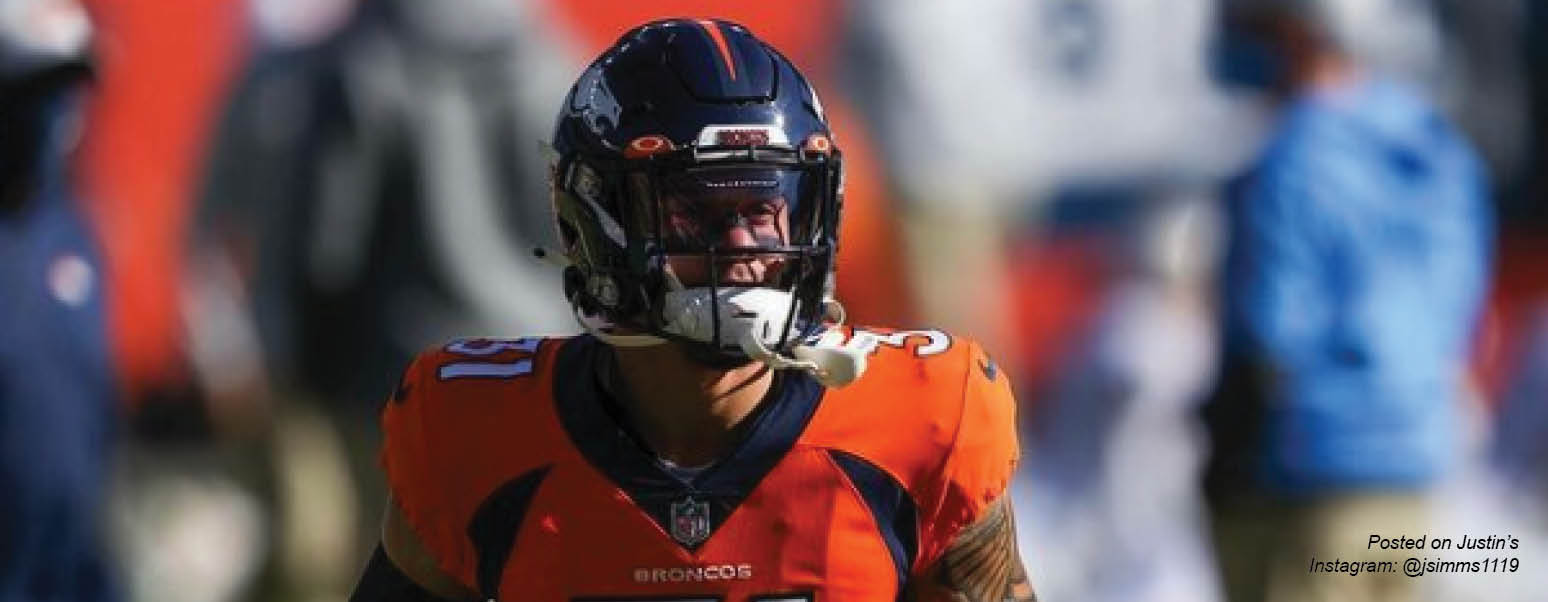
From Down Syndrome WorldTM 2021 Issue 3 of 4
Denver Bronco Justin Simmons and GLOBAL model Leeon Grullon share how balance is the key to good health and a good life.
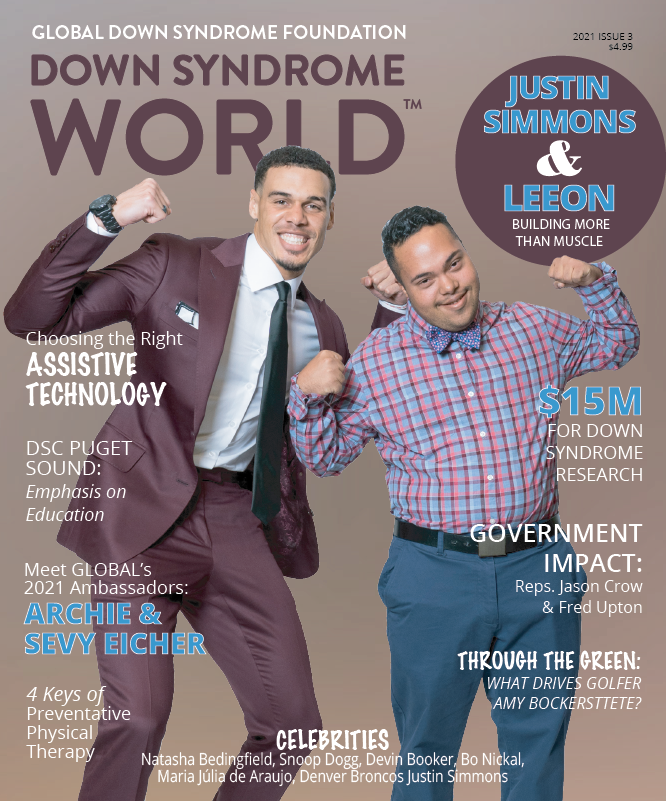 This article was published in the award-winning Down Syndrome World™ magazine. Become a member to read all the articles and get future issues delivered to your door!
This article was published in the award-winning Down Syndrome World™ magazine. Become a member to read all the articles and get future issues delivered to your door! “WHEN LEEON WAS BORN, I could tell something was different about him from his physical features. It wasn’t until a few days later, when Leeon was in the ICU unit, that I received his Down syndrome diagnosis. The nurse who told me said it was best to give him up for adoption,” says Florida native and mother of two, Karla Cubilla. “It was a confusing and emotional time, but I was strongly bonded to Leeon and determined to move forward in life with him, whatever it took. All my efforts went into making sure he was healthy.”
As a professional nutritionist, Karla understands the huge impact that a person’s health makes on their overall quality of their life. Leeon (now 25) and his big sister, also named Karla (26), were raised to prioritize wellness and self-care to live a well-rounded healthy lifestyle. The goal is to find balance in all their activities. This includes a focus on the usual health elements like eating a nutritious diet, incorporating adequate supplements, and exercising regularly, while also keeping up with other important elements that often get overlooked, like social activities, mental stimulation, and emotional wellbeing. Today, the family is living happily in San Antonio, Texas. Karla, the mother, met her fiancé John in San Antonio and is currently building her own nutrition company for athletes. Her daughter Karla is now a licensed occupational therapy assistant in the city, while also managing her own family business. Leeon is a competitive powerlifter and athlete in Special Olympics. In his free time, he enjoys lifting weights and playing sports with friends, while also working on his other talents like DJing, cooking, and Karate. The family has found a variety of fun social activities in their new city, allowing them to continue their balanced lifestyles.
When Leeon was selected as a model for Global Down Syndrome Foundation’s Be Beautiful Be Yourself Fashion Show in 2018, he brought his bright, positive spirit into the spotlight. Leeon’s energy filled the room, and eventually caught the attention of Denver Broncos’ Justin Simmons. Leeon was thrilled to hang out with Justin. The two posed for photos together, where smiles for the camera quickly became a show of muscle flexing and laughter.
“Events like GLOBAL’s fashion show provide an opportunity to learn from amazing people and give back. We all need a community of support and love to be our best selves,” says Justin, who is a dedicated GLOBAL supporter and a regular attendee of the event. He has a similar outlook to Leeon on creating a full, balanced life. “When everything in your life is in line, it allows you to welcome and seize opportunities as they come your way.”
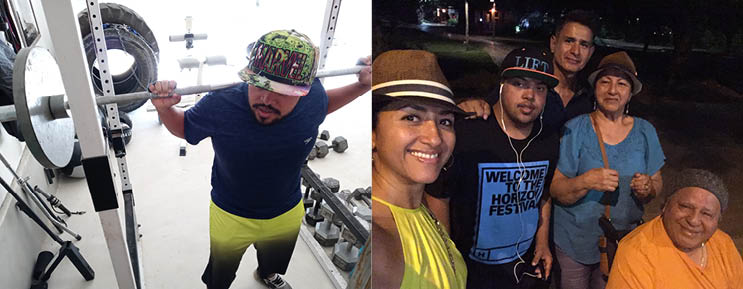
EARLY INVESTMENT
To create a supportive environment for Leeon, his mother Karla had to create a community from the ground up. “The biggest challenge in raising Leeon was the lack of supportive resources. Sure, I was directed to programs and specialists, but it was up to me to find within and around, that heart-centered emotional support.” At the time Leeon was born, there was no local Down syndrome organization in the area, so Karla used the online community to connect with other parents raising a child with Down syndrome. One common theme Karla learned from the stories she read was the importance of having a strong support team starting at early childhood. Before Leeon was one, he was already enrolled in specialized educational and therapy programs.
Leeon’s teachers have played a big role in his journey so far, influencing both his cognitive progression and at times, regression. “Leeon has had some amazing teachers in his life, ones who really challenged him and pushed him to get to the next level, and then there were others who lacked patience and understanding, which is disheartening to see in the field,” Karla explains.

With varying levels of teacher support from year to year, Leeon’s academic career had ups and downs. To get Leeon back on track with school, he and his mom developed a structured home-school schedule. “For anyone, and especially for people with Down syndrome, repetition is important because it reinforces learned behaviors and allows you to build upon that and grow,” Karla says. The schedule followed the same guidelines they used in their healthy lifestyle planning: establish a balance and create healthy habits in multiple areas of life that all feed into accomplishing a bigger goal.
Leeon’s home-school routine included time blocks for homework and studying, family time, physical exercise, social activities, and pursuing his hobbies. Karla’s goal was to bring balance while reinforcing the things Leeon was learning through tutoring, which his previous school had not provided enough of. Establishing a routine creates a work-life balance that allows Leeon to easily manage all the things he wants to do, rather than feeling too overworked in one so another is deprived. For example, after a study session with tutors, Leeon would do something that he enjoyed even more and was both fun and healthy, like lifting weights and doing cardiovascular-friendly routines at the local gym with his friends. “It’s all connected. There was a beautiful integration of Leeon’s growth, while he was becoming a better athlete and a teammate, it was at that same time that his reading and language skills excelled,” Karla says proudly.
Leeon’s lifestyle allows him to center his day around doing what makes him happy. According to Leeon, “I lift weights, that’s how I’m so good looking! I bench press, do push-ups, and lift dumbbells. I like to go to Karate. All the time my mom has me doing yoga. I like it too.”
At just 25 years old, Leeon has accomplished a skill that many people spend their lives trying to master and don’t: discipline.
ROAD TO THE NFL
In 2016, the Denver Broncos selected Justin Simmons in the third round of the NFL draft, and Justin has been the team’s free safety since. The Virginia-born, Florida-raised athlete attributes his success to his faith and a supportive community of friends and family. “I grew up in a Christian home with a white mother and a black father, and I was the oldest of three boys. At times, it was difficult to get both sides of the family to agree on things. But in the face of arguments or disagreements, my parents taught us to unite by putting our faith first. This devotion to our faith allowed us to turn those challenges into opportunities for growth and love.”
This philosophy has guided Justin through his career and his life. “My parents always let me make my own decisions and supported me whether they agreed with them or not. With that strong support from them and my faith in God, I knew everything would be okay,” Justin adds.
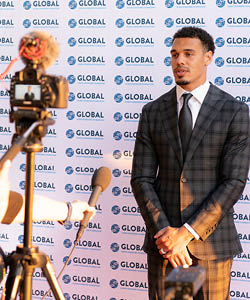
In high school, Justin preferred basketball as his top sport and had dreams of playing in the NBA. When he began to receive college scholarships for football, he reassessed his options and started to focus on finding his intended path. He was thrilled to get a full scholarship offer from Boston College and eagerly accepted the opportunity.
“Playing college football was extremely humbling. You go from being the best player in your high school to playing in college, where every guy was the best in their high school,” says Justin. “The first couple years were really tough. You’re tempted to get discouraged and doubt yourself, but you have to keep grounded and just earn your spot.”
Justin explains how in these moments, your faith and discipline are being tested and it’s your job to call upon yourself to rise above it and prevail. “Be mindful of what you’re giving your attention to, don’t get caught up in other people’s negative perceptions. There’s a reason you’re driven to do certain things and a reason you’re presented with opportunities to do them. All you have to do is do those things to the best of your ability.”
Entering the NFL, where the competition, criticism, and pressure is magnified times 100, is just another test of strength and character. “As athletes, we’re constantly picked apart and criticized. Mental health is so important because without it, you may start to believe those negative perceptions reflect who you are. What’s most important is being confident in who you are, and knowing you are much bigger than football.”
Outside of football, Justin loves spending time with his family. He is married to his high school sweetheart, Taryn, and together they have a beautiful three-year-old daughter Laney, and another baby girl on the way. Justin and Taryn’s goal as parents is to love their girls and raise them to be the best versions of themselves.
Justin has been recognized locally and nationally for his leadership in the community. He was recently elected a Broncos team captain for the 2021 season. Justin has received the Denver Broncos’ Community Ambassador Award, the Darrent Williams Good Guy Award in 2017 and 2019, and was selected as the team’s Walter Payton Man of the Year Award nominee in both 2019 and 2020.
Justin and Taryn launched the Justin Simmons Foundation in June 2020. “I know that if my community of support hadn’t invested in me, I wouldn’t be where I am today. We need to invest in our youth. They are the future,” says Justin. The foundation provides various services to young people, including opportunities for mentorship, education, athletics, and more. “Launching during a pandemic was definitely not what we expected, but we’re proud of the work we’ve done so far. Now with COVID restrictions lifting, I am really looking forward to getting together with the kids and meeting them face to face!”
As Justin has experienced firsthand through his work with GLOBAL and other Down syndrome organizations like Best Buddies, children who are differently-abled are key members of our youth. “There’s so much we can learn from people with Down syndrome. Their attributes of kindness, generosity, and love are a blessing to everyone around them. They are super smart and capable of accomplishing great things when given a chance to reach their potential.”
As a son, brother, husband, father, friend, and teammate, Justin aims to be a source of inspiration, hope, and support for others.
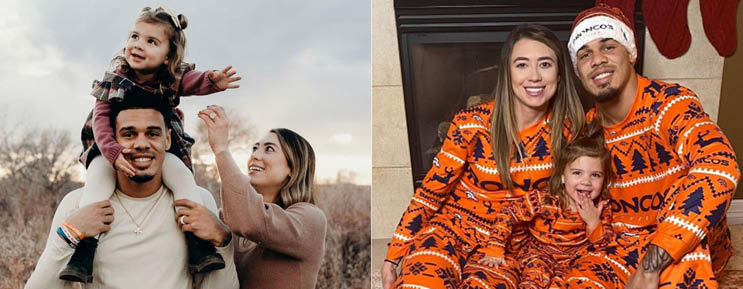
COMMUNITY OF LOVE AND SUPPORT
Leeon and Justin have learned that having a good life is easy, all you need to do is build yourself to be the best version of you. GLOBAL’s Be Beautiful Be Yourself Fashion Show, where Justin and Leeon met in 2018, embodies that exact philosophy. The event brings people together from all over the world, united to celebrate and support people with Down syndrome.
Justin recalls, “My first time attending GLOBAL’s Fashion Show, I went in thinking it would be a fun, good thing to do with my teammates. You walk in excited to see these big stars like Jamie Foxx and Shia LaBeouf, but then you realize, it’s not even about them. The entire night is about the people with Down syndrome, and everybody knows it. You’re focused on how much fun the models have on the runway and learning about the advocacy efforts to support them. I left feeling so humbled and inspired.”
Leeon loved every minute of being a GLOBAL model. “The whole thing was amazing. It was one of the best nights of my life. My favorite part was waking up that morning, getting dressed up and ready to model for the big show. Taking pictures with professional athletes backstage was another favorite moment,” he says, keeping it cool and just happening to leave out that he walked down the runway with a Broncos cheerleader on each arm!
The Be Beautiful Be Yourself Fashion Show is the largest fundraiser for Down syndrome in the world, having raised over $22 million for life saving research and medical care. The event has received 17 national awards and continues to attract over 1,400 people each year, including featured celebrities such as John C. McGinley, Beverly Johnson, Peyton Manning, Queen Latifah, Natasha Bedingfield, Alec Baldwin, Eva Longoria, and more.
“Quincy Jones set the stage for using his celebrity platform to promote important causes, like Down syndrome awareness. When it comes to philanthropy and giving back to the community, Quincy is the ultimate role model and a living legend,” says Justin. Every year, GLOBAL gives the Quincy Jones Exceptional Advocacy Award to two strong leaders in the community, one leader with Down syndrome who can speak directly for their community and another person with a celebrity platform who can share GLOBAL’s message to the masses.
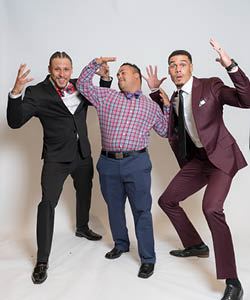
“The event itself is a huge awareness-raiser featuring over 20 models with Down syndrome some of whom are celebrities in their own right,” says GLOBAL President and CEO Michelle Sie Whitten. “The evening actually changes you, especially if you are new to the Down syndrome community. You walk away understanding what discrimination and struggles we face, but also celebrating our advances in inclusion and life-changing research and medical care.”
Karla’s main takeaway was a common one that many parents have: good health is the common denominator for a good life. Karla tells, “As parents of children with Down syndrome, we’re always asking questions. Information is a vital part of our journey. It is with information that we can better understand the unique physiology of our children with Down syndrome and learn how to best assist them. Information makes us aware of choices that could enhance our child’s life. My continuous search for information is what led me to the Global Down Syndrome Foundation. GLOBAL is a valuable source for information, they have answers to our questions, even for the ones we didn’t know to ask. We need to help GLOBAL advocate for increased funding for Down syndrome research.”
SAVE THE DATE! To buy tickets for GLOBAL’s 2021 virtual Be Beautiful Be Yourself Fashion Show, visit bebeautifulbeyourself.org
What You Should Know About Celiac Disease & Down Syndrome
September 28th, 2021 by admin

From Down Syndrome WorldTM 2021 Issue 3 of 4
Symptoms, Treatment, and Misconceptions
 This article was published in the award-winning Down Syndrome World™ magazine. Become a member to read all the articles and get future issues delivered to your door!
This article was published in the award-winning Down Syndrome World™ magazine. Become a member to read all the articles and get future issues delivered to your door! WHAT IS CELIAC DISEASE?
Celiac disease is an autoimmune disease that is triggered by eating gluten. Unlike a gluten intolerance, celiac disease damages the small intestine, making it difficult for the body to absorb much-needed nutrients. About 1% to 3% of the general population is estimated to have celiac disease, but one recent study estimates that people with Down syndrome are six times more likely to develop celiac at some point in their lives. Celiac disease can cause intense pain and have major long term health impacts. It is important for people with Down syndrome to learn to recognize the symptoms and to follow a strict treatment protocol in order to maintain a good quality of life.
MEGAN’S DIAGNOSIS
Megan Bomgaars, reality TV star and GLOBAL Q-Awardee, inspires people all over the world with her incredible advocacy. She’s known for her big personality and ability to move a room to tears with her powerful words. What many don’t know about this strong woman is that she also has celiac disease.
Megan’s mom, Kris Bomgaars, recalls when Megan’s doctors told her Megan was experiencing failure to thrive, a medical condition characterized by inadequate growth. She was small for her age and had chronic sinus infections. By the first grade, she was experiencing abdominal pain, vomiting, and constipation on an almost daily basis. Megan’s teachers told Kris that these symptoms were the result of school avoidant behavior and a bad attitude, but Kris didn’t buy it. “Well, I knew as a mom, and also as a special education teacher, that she actually really loved school, and she loved every subject in school,” Kris remembers. Kris noticed that Megan’s gastrointestinal symptoms consistently occurred after eating the school-provided lunches every day, which made her think that Megan was having a reaction to ingredients in the meals. It still took months of advocating for her daughter to get a diagnosis. “There was one week I took her to the pediatrician every single day because she was literally crying in pain.”
At first, Megan’s doctors diagnosed her with malrotation (a condition where the intestines do not form correctly), but when they performed surgery, they found that Megan’s small intestines had completely atrophied. It was only then that the doctors confirmed that Megan had celiac disease through a blood test and a biopsy.
LEARNING ABOUT CELIAC DISEASE
Megan’s story is a common one for people with Down syndrome who also develop celiac disease. Dr. Marisa Stahl, a pediatric gastroenterologist at the Colorado Center for Celiac Disease, says that the wide variance of symptoms and overlap with other autoimmune and gastrointestinal disorders (common in Down syndrome) makes diagnosing celiac disease difficult, especially with children who may have difficulty expressing their symptoms. Celiac disease can develop at any age and having a celiac diagnosis also may indicate that you have a predisposition for developing other autoimmune diseases.
The most common symptoms of celiac disease include:
- Abdominal bloating and pain
- Chronic diarrhea
- Vomiting
- Constipation
- Brain fog or headaches
- Weight loss or poor weight gain
- Irritability
- Delayed growth or puberty
- Fatigue
- Anemia
- Behavioral changes
Any or all of these symptoms could indicate celiac, although Dr. Stahl notes that celiac can also manifest as other symptoms of autoimmune disease. She says, “It can affect every system in your body. Continued exposure to gluten over time can lead to long-term consequences, such as poor growth, vitamin deficiencies, neuropathies, osteoporosis, and certain intestinal lymphomas, just to name a few.” It is also possible to have celiac and not have any symptoms, a condition known popularly as “silent celiac.”
Even asymptomatic celiac disease causes damage to the small intestine, so screening is important for those who may be at higher risk. There are two common tests for celiac disease: the first is a blood test, also known as the tTG-IgA Test. Because eating gluten causes an increase in certain antibodies for people with celiac, testing for these antibodies in the blood of someone who might have the disease often can point doctors in the direction of a diagnosis. If the blood test reveals an increase in those antibody responses, medical professionals will administer the second test, an endoscopic biopsy. This biopsy is a minor surgical procedure where a doctor will test a small part of the patient’s small intestine for signs of damage. The biopsy is currently the most common way to diagnose celiac disease. There are some special circumstances where the diagnosis may be made based on additional blood testing.
WHAT IS THE TREATMENT FOR CELIAC?
The only treatment for celiac disease is a total and lifelong gluten-free diet. This diet relies not only on eating gluten-free food but also on embracing a gluten-free lifestyle. Some forms of celiac are more sensitive and require elimination of all gluten-free products, but eliminating any ingestion of gluten is essential. As Megan learned through her journey with celiac, many shampoos, toothpastes, cosmetics, and even stickers contain gluten. Many medications have some form of gluten as one of their ingredients. Cross-contact is also an issue: the same kitchen equipment used to prepare meals with gluten cannot be used to prepare gluten-free food. Once Megan started her gluten-free diet (she also eliminated dairy), her symptoms disappeared, and she began to thrive in a way Kris had not seen before. She grew four inches over the summer, her previously frequent sinus infections ceased, and she no longer had the daily abdominal pain or other gastrointestinal symptoms that made school so difficult. Kris remembers being amazed at the transformation: “All it took was a diet change, and it changed the entire course of her life.” Megan does not remember life before the diagnosis, but she is very aware of the consequences of coming into contact with gluten based on a few accidental encounters over the years. Even the smallest contact will make her sick for days.
There is ongoing medical research for other treatments for celiac disease, including some promising medications, Dr. Stahl says, but none of them are currently as effective at preventing symptoms and long-term damage as a gluten-free lifestyle.
COMMON MISCONCEPTIONS ABOUT CELIAC
Because of the recent popularity of gluten-free diets over the past decade (especially due to high profile celebrities adopting this diet), there has been an exponential increase in the availability and awareness of gluten-free food. Restaurants like P.F. Chang’s (one of Megan’s favorites) have begun providing designated gluten-free menus with procedures to ensure no cross-contact. Kris notes that stricter labelling laws have also made it much easier to determine if a product is gluten-free, and because labels are more accessible, Megan has gained independence over her shopping and eating habits. There are even apps now where you can scan the barcode of a product, and the app will tell you if it contains gluten. Kris says that it is much easier now to navigate eating out than it was when Megan was first diagnosed. “I mean, in the beginning, I remember one time I asked for a gluten-free menu, and this poor server handed me a martini menu,” she recalls.
However, this newfound trend of gluten-free diets has also led to some misconceptions about celiac as well. Dr. Stahl believes that this is in part due to “a lot of celebrities who also follow a gluten-free diet because they perceive it as being healthier. As a result, there are a lot of restaurants that have developed, for instance, gluten-friendly menus, but they’re really not taking the strict precautions that you need to take in order to ensure serving safely gluten-free foods, things like cross-contact.” Kris says that at first, people sometimes believe that she and Megan follow a gluten-free diet as part of a fad, not realizing the serious consequences of Megan eating gluten. One of the more difficult challenges of Megan’s diagnosis was educating family members. She recalls asking, “Does grandma really understand what gluten is? Because for that generation, celiac disease really wasn’t that big of a deal.”
On the other hand, Kris said that some parents of Megan’s friends stopped inviting her to birthday parties or to other playdates because they were afraid of the consequences of accidentally feeding her gluten. “She didn’t get a lot of invitations until I started saying I’ll pack every ounce of food, you don’t need to worry about it. It’s not anaphylaxis, so it’s not like a peanut allergy.”Much of social life in the U.S. and around the world revolves around food and dining out, so it can be extremely difficult for people with celiac to maintain a social life if the people around them are not willing to learn or accommodate their dietary needs.
WHAT SHOULD I DO IF I THINK MY CHILD OR I MIGHT HAVE CELIAC?
Dr. Stahl notes that while there is no consensus on screening guidelines for celiac disease for people with Down syndrome, her center recommends that screening begin at 3 years of age, unless symptoms begin to develop earlier. She also notes that screening should continue at intervals because celiac disease can develop at any age. It is important to note that these symptoms could also indicate other gastrointestinal or autoimmune conditions; it is also important that you consult your doctor if you suspect your or your child’s symptoms might be caused by celiac. Trying to implement a gluten-free diet on your own without a diagnosis and support from medical professionals and a dietitian is not advisable, Dr. Stahl says. You could be eliminating important sources of fiber and other nutrients without the proper education. She also advocates that anyone diagnosed with celiac disease, especially those with Down syndrome, see a psychologist. Major changes in diet, especially if food is a source of comfort or social inclusion, can have a negative impact on mental health, so it is important that someone recently diagnosed with celiac develop support systems.
Kris recommends that if you or your child has recently received a diagnosis of celiac that you join a celiac support group. “The best advice I got was from other people who had celiac disease,” Kris shares. The one that Kris joined when Megan was first diagnosed helped her learn to read labels and other strategies for how to determine which foods were safe.
Megan says that her diagnosis doesn’t prevent her from enjoying food. She enjoys rice, sushi, gluten-free and dairy-free pizza, and making her own ice-cream sundaes.
To learn more about celiac and to find resources, please visit
celiac.org/about-celiac-disease/symptoms-of-celiac-disease
How An Unexpected Diagnosis Unveiled A Beautiful Treasure
July 29th, 2021 by admin
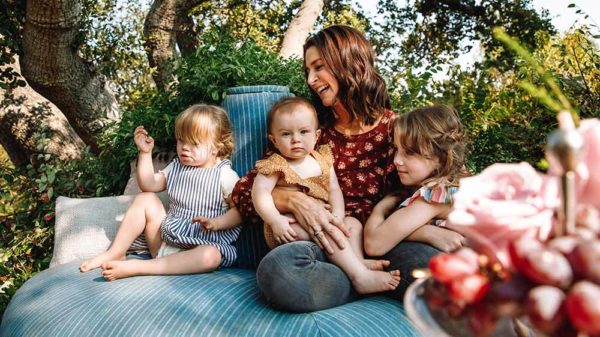
Caterina Scorsone and family (photo by Rebecca Couresy)
Actress, advocate, and mother of 3, Caterina Scorsone shares how having a child with Down syndrome challenged her to open her mind. What she discovered changed her life.
Best known for her role as Dr. Amelia Shepherd on ABC’s Grey’s Anatomy, award-winning actress Caterina Scorsone has spent her career playing different characters by learning how to empathize and connect with people, a skill she developed as a child actor in Canada. In November of 2016, Caterina received unexpected news and she had to prepare for her most challenging role yet: mother to a child with Down syndrome.
When Caterina learned that her daughter, Paloma, “Pippa,” had Down syndrome, she recalls feeling scared and intimidated by the diagnosis. “I have always been the type of person who tackles challenges with careful planning and thoughtful preparation, and this, I was completely unprepared for,” Caterina explains. “And that caused me so much anxiety and worry. What type of mother did that make me, not knowing how to care for my own child?”
Honing her years of practice studying how people think, feel, and act, Caterina realized she had all the tools she needed to be a good mother to Pippa. “No one is ready for a Down syndrome diagnosis for their child, but they become ready one way or another, because they have to.
“Pippa has taught me how to be a better mother to all my children, and to be a better person in general. A better friend, sister, daughter, colleague,” says Caterina, who is using her public platform to share her parenting experiences with the world.
A rising advocate in the Down syndrome community, Caterina hopes to spread awareness to society and serve as a source of information and support for families.
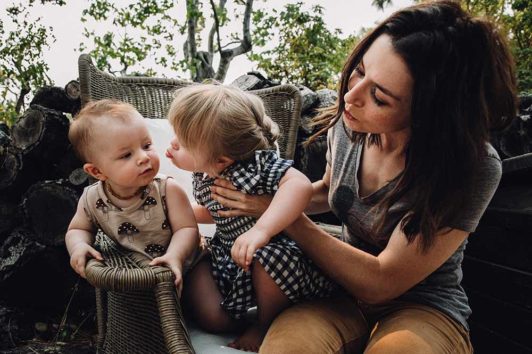
Caterina Scorsone with her family (photo by Rebecca Couresy)
Motherhood
Today, Caterina is a mother to three beautiful children: Eliza (9), Paloma aka “Pippa” (4), and Lucinda aka “Lucky” (19 months). She says that while they are all very different from each other, the thing all her children have in common is their very distinct and strong personalities. The proud mother describes Eliza as the problem-solver and creative thinker, Pippa as insightful and determined, and Lucky as fun-loving and strong.
Caterina shares how her ever-changing and ever-growing journey as a parent has continued to challenge her and teach her important lessons.
“When I was pregnant with my first, Eliza, I was so excited and ready to be a mom. I wanted to make sure I was the best mom I could be, so I read all the books and articles I could find on parenting. It was like preparing for a role. By the time Eliza was born, I felt really prepared.
“Three years later, when Pippa was born, the whole game changed. When we received her Down syndrome diagnosis, I was scared. I was intimidated by my lack of knowledge and skill in this area. I didn’t know what her needs would be or how I would meet them. I worried about what the future would hold for her.”
Searching for support and information, Caterina was frustrated by the lack of resources available to new parents of children with Down syndrome. She recalls how, at first, she allowed her frustration to take over, and her mind became overwhelmed with thoughts of fear, worry, and doubt. “My mind was stuck in the future, worrying about all the what-ifs, that I was missing the what-is right in front of me,” Caterina explains.
Caterina realized she needed to put her worries aside and move her focus to the real priority – which was to be there for her children. Shifting her focus to Eliza and Pippa, Caterina’s worries transformed into curiosity. She observed how the two interacted with each other and how both were developing and growing, in their own ways, at their own speed.
Caterina describes Pippa as very determined, insightful, sensitive, fun, and honest. “One of the most beautiful things about Pippa is how connected she is to her experience. If she wants to do something, she is very excited to do it and thoroughly enjoys it. And if she doesn’t want to do something, she is very connected to her gut and knows what she doesn’t want. Pippa’s self-acceptance frees her limiting beliefs, like worry about other people’s expectations of her.
“Once I embraced the diagnosis, I was able to appreciate what it invited into our lives, which was a beautiful shift in perspective that enhanced our whole way of living. Pippa has forced me to leave behind preconceptions about who people are and what they should or should not be like. It allowed me to see every person I encounter as completely unique, no longer subjected to some sort of list of standards that people are either succeeding or failing to live up to. I had to radically reconsider everyone’s individuality, including my own.”
In December of 2019, when Caterina had her third daughter, Lucinda, “Lucky,” she felt more prepared than ever before. Caterina knew this newfound life perspective would instill important values in all her kids and that she could handle any challenge that comes their way with grace. Similar to the creative environment she grew up in, Caterina says the family enjoys lots of dressing up and dance parties together in their home.
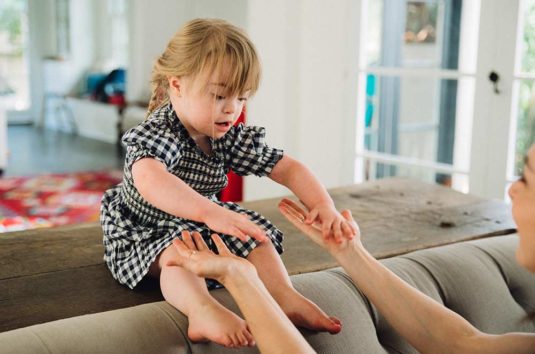
Pippa Scorsone daugther to Caterina Scorsone (photo by Rebecca Couresy)
Giving Back
“When Caterina took to Instagram to announce Pippa’s birth and diagnosis with excitement, we could tell right away that she was one of us and that she would be a powerful voice in the Down syndrome community,” says GLOBAL President and CEO, Michelle Sie Whitten. “After developing a relationship with her over the next several years, and learning about her passion for our research, we proudly selected Caterina as the recipient of our 2020 Quincy Jones Exceptional Advocacy Award, GLOBAL’s most prestigious honor.”
Due to COVID-19 restrictions, Caterina accepted the award virtually at the 2020 Be Beautiful Be Yourself Fashion Show. Caterina was proud to be a co-awardee with Spanish model Marián Ávila, who is dedicated to getting people with Down syndrome more represented in the media. “Marián is such a beautiful person inside and out. After the show, she even mailed me a box of ‘Congratulations’ chocolates! It was such a personal, sweet touch,” Caterina remembers.
As a GLOBAL advocate and spokesperson, Caterina aims to use her public platform to raise awareness about Down syndrome and help new parents navigate the diagnosis. “I want to help new parents feel less scared and more excited about their child’s future, knowing that they have support,” she says. “My hope is that as a culture and a society, that we can learn to lead with the person, not the diagnosis. That we can recognize the humanity in each one of us. The Global Down Syndrome Foundation embodies that vision.”
One of the elements of GLOBAL’s work that Caterina feels most passionate about is the breakthrough research. “GLOBAL’s research arm, the Crnic Institute, published a groundbreaking study on how the overactive immune system in people with Down syndrome is part of a different disease spectrum, which opens up so many opportunities for research,” Caterina explains. “It’s really hard as a parent to make sound medical decisions for your child when the information that your doctor has is often not complete based on the genetic makeup of our kids with Down syndrome. It’s priceless to have the full picture of information.”
Caterina encourages families who are interested in advocacy to read about the important breakthroughs in research on GLOBAL’s website and to join them in their fight for increased federal funding for Down syndrome research.

Pippa Scorsone daugher of Caterina Scorsone (photo by Rebecca Couresy)
“Down syndrome is just one aspect of the deep and multi-faceted human beings that have the condition,” Caterina continues. “I’ve found that the key to being a good parent, and a good person, is in curiosity. Be curious about your children and who they are. Be curious about yourself. Be curious about what scares you. Lead with the search for knowledge and understanding, rather than judgement, and you will be surprised by how much you will continuously learn about the world.”
To learn more about Caterina and to watch her inspiring Quincy Jones Award speech, visit www.bebeautifulbeyourself.org/caterina-scorsone
To access GLOBAL’s informative resources on research and medical care, visit www.globaldownsyndrome.org/about-down-syndrome/resources
Like this article? Join Global Down Syndrome Foundation’s Membership program today to receive 4 issues of the quarterly award-winning publication, plus access to 4 seasonal educational Webinar Series, and eligibility to apply for Global’s Employment and Educational Grants.
Register today at downsyndromeworld.org!
Pursuing Your Passions
November 17th, 2020 by Global Down Syndrome Foundation
From Down Syndrome WorldTM 2020 Issue 2 of 4
FROM OWNING A RESTAURANT TO RUNNING A FOUNDATION, TIM HARRIS IS ON A MISSION. THE DEDICATED GO-GETTER FINDS NEW INSPIRATION AFTER MEETING R&B POWER COUPLE SHAMARI & RONNIE DEVOE AT GLOBAL’S FASHION SHOW.
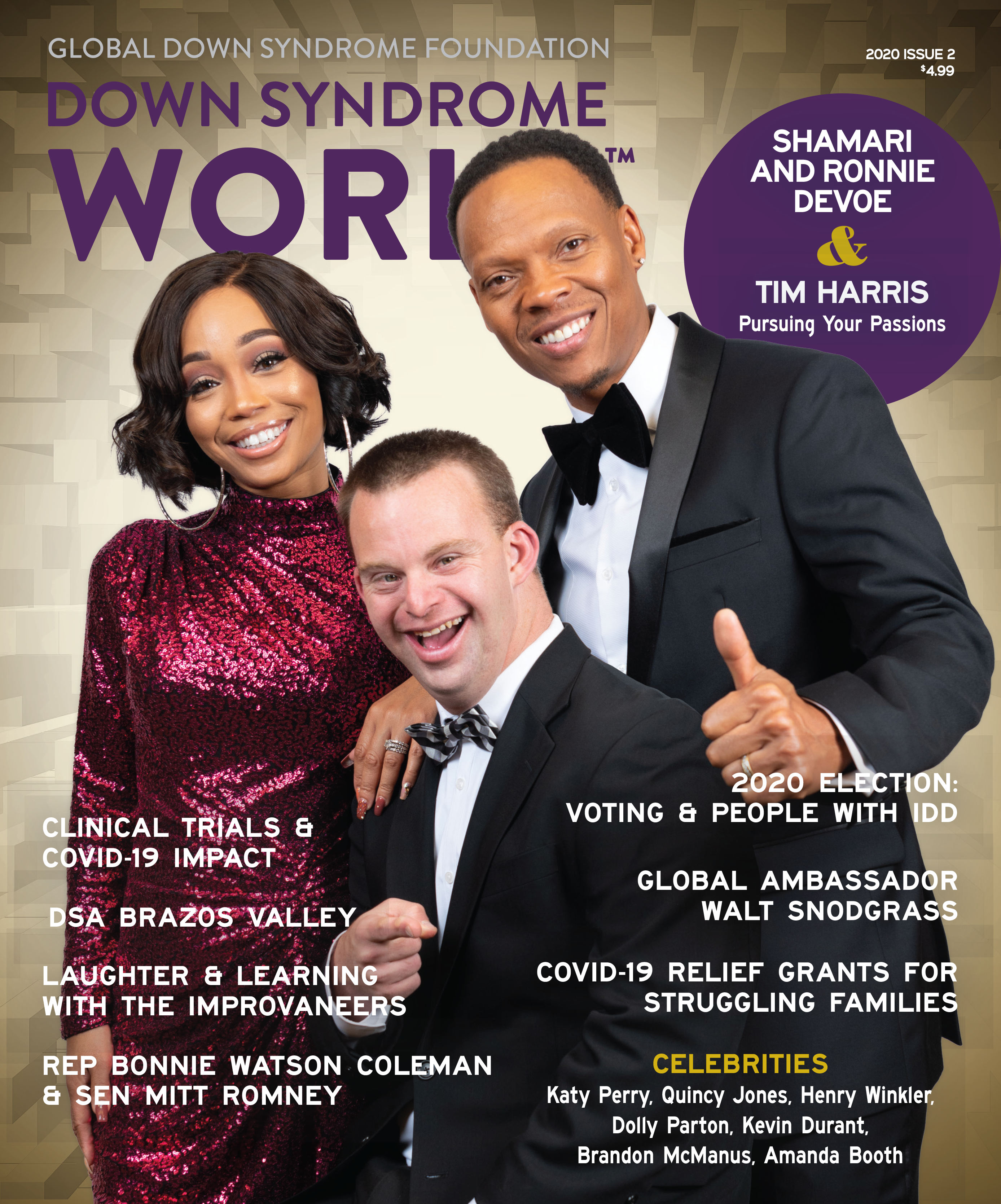
This article was published in the award-winning Down Syndrome World™ magazine. Become a member to read all the articles and get future issues delivered to your door!
“IF YOU CAN DREAM IT, YOU CAN DO IT,” Tim Harris, the vibrant 34-year-old from Albuquerque, New Mexico, says with a smile. “That famous Walt Disney quote has led me through my life.”
From the time Tim was a kid, he dreamed of owning a restaurant. After graduating college, he made that dream a reality and opened “Tim’s Place” in 2010. The restaurant served classic American and New Mexican dishes but was more well-known for Tim’s world-famous hugs. Tim became the first person with Down syndrome in the United States to own and operate his own restaurant. The restaurant attracted celebrities like Paul Bettany, Jennifer Connelly, Aloe Blacc, J.R.R. Martin, and Mel Gibson, parents of newborns with Down syndrome, and national media outlets. Tim was also featured in People Magazine, CBS Evening News and CBS Sunday Morning, America Online, ABC News, NBC Today Show, NBC Nightly News, National Public Radio, and CNN News.
After an impressive 75,402 hugs over 5 years, Tim and his family decided to close Tim’s Place. Seeking to expand his impact, he started Tim’s Big Heart Enterprises in 2016, hosting charity events such as the Hug-A-Thon for the local fire department. Now, Tim spends his time traveling the world, advocating for those with Down syndrome, and giving motivational speeches. Tim is also a recipient of the Quincy Jones Exceptional Advocacy Award, the prestigious honor given by the Global Down Syndrome Foundation (GLOBAL).
At GLOBAL’s 2019 Be Beautiful Be Yourself Fashion Show, Tim had the pleasure of watching his girlfriend Megan Bomgaars accept the same award. “Megan asked me to escort her on the red carpet, and it felt awesome having reporters ask us about our advocacy together. I loved it,” Tim explains.
That night at the Fashion Show, Tim met Shamari and Ronnie DeVoe, who are known as a power couple in the music industry. Shamari is a platinum artist and actress, best known for her role on the Real Housewives of Atlanta. Ronnie is also a platinum selling artist, best known for being in the bands New Edition and Bell Biv DeVoe as well as his off-stage career in real estate.
“We learned about GLOBAL and the Be Beautiful Be Yourself Fashion Show from our friends Jamie and DeOndra,” says Shamari. “The Fashion Show was a perfect way to combine our passions for music, helping others, spending time with friends and making new ones
all in one night.”
“Jamie Foxx and his sister DeOndra Dixon are long-time GLOBAL supporters and an iconic sibling duo. Seeing them at GLOBAL events over the years and meeting a successful power couple like Shamari and Ronnie was inspiring,” says Tim. “I thought, hey look at all Megan and I have accomplished on our own, I wonder what we could accomplish together! TiMeg? BomHarris? We’ll need to work on that.”
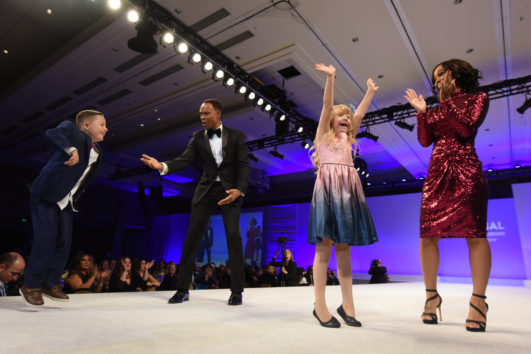
From a Solo Force to Power Couple
“The most important thing we’ve learned about being a success- ful couple, both professionally and personally, is to be a strong individual in both areas first,” says Ronnie. “Shamari and I developed ourselves and our careers years before even meeting each other. When we met, we combined our talents and became even stronger together.”
Ronnie grew up in Boston, Massachusetts and was always interested in the entertainment industry. In 1980, Ronnie’s uncle Brooke Payne introduced him to the guys in New Edition after they won a chance to record a song with Maurice Starr, a well-known pop and soul music producer. He auditioned to become the 5th member and three years later, they released their first record, Candy Girl. New Edition broke up in 1989. After that, Ronnie, Ricky Bell, and Michael Bivins founded Bell Biv DeVoe. “Their debut album, Poison, sold more than 5 million copies and garnered 5 hit singles including the timeless classic, Poison.” New Edition reunited in 1996 with the #1 album Home Again. Since then, NE and BBD have received all kinds of accolades, lifetime achievement awards, and even produced a record-breaking movie about their journey in the music business. BBD’s most recent album was released in 2017 and the group continues to tour around the world.
Shamari grew up in Atlanta, Georgia and started singing when she was just 3 years old. At 17, she landed her first record deal on the multi-platinum group Blaque, with Lisa Lopes. In 1999, the group won “Best New Artist” by Billboard for their debut album, which sold over one million copies. In addition to her music career, Shamari has appeared in the movies Bring it On and Honey, and TV shows V.I.P. and Bravo TV’s Real Housewives of Atlanta.
In 2001, Ronnie and Shamari met at the after party for the MTV Icon Awards honoring Janet Jackson in Los Angeles. From that day on, they were inseparable. Their involvement in the music industry helped connect them and strengthen their relationship over the years. “We share the same love for traveling and inspiring people through our music and performances,” says Ronnie. The couple was married in 2006, and in 2017, they welcomed twin boys, Ronald and Roman. Ronnie and Shamari began to collaborate on music together and in 2018, they released Love Comes Through, their first song together.
When Tim met Shamari and Ronnie, they got along right away. “They were so fun to be around and easy to talk to,” he remembers. And the feeling was mutual. “Tim is an amazing individual with loads of energy, ambition, and laughter,” says Shamari. “His spirit and personality were infectious. He made us feel right at home. I can see why his restaurant was so successful.”
Tim and Megan had a similar journey of individual growth before they met. Tim attended Eastern New Mexico University and graduated in 2008 with certificates in restaurant management. His restaurant, “Tim’s Place,” became famous for being the “friendliest restaurant” in the country and he was invited to be a keynote speaker for and received awards from dozens of organizations including Keller Williams International, Clay Aikin’s National Inclusion Project, Children’s Miracle Network, The NYC Welcome Conference, National Down Syndrome Congress, Special Olympics International, Kiwanis International, Civitan International , and many more. Additionally, Tim’s foundation has successfully raised thousands of dollars for organizations in his local community.
“Tim brings such joy to everyone around him,” says his mother, Jeannie. “He’s always been a big hugger. He makes everyone feel loved and celebrated.”
“His happy attitude brings him from one adventure to the next,” his father Keith adds. “If one door closes, he won’t spend too long dwelling on it, he’ll just move on to the next thing. And that’s what allows him to accomplish so much.”
Regularly attendees of GLOBAL events, Tim met Megan at one of GLOBAL’s “must-attend” quarterly I Love You Dance Parties, where Megan was being followed by a camera crew for the Emmy-award winning Born this Way. Not intimidated, Tim began to court Megan, they got to know each other as friends, and eventually started dating. But continue to prioritize their careers along the way. After several months of dating, at GLOBAL’s 2019 Fashion Show, Tim made their relationship public and official. “I gave her a special necklace, and she kept it!”
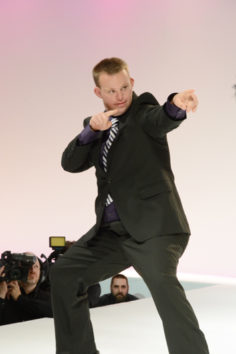
Megan is a businesswoman in her own right. Her student video about inclusive learning environments, where she coined her catch phrase “Don’t Limit Me” went viral in 2013. She was later recruited to be cast on A&E’s Emmy Award winning show Born This Way. Additionally, Megan is an entrepreneur, opening her own clothing line in partnership with Sanrio’s Hello Kitty and “Don’t Limit Me” makeup line in collaboration with Artpop Cosmetics.
“It was so heartwarming to see how supportive and encouraging Megan and Tim are to each other,” says Shamari. “Tim gave Megan her spotlight as the 2019 Quincy Jones Award winner, and Megan was proud to show Tim off.”
When Tim asked Ronnie and Shamari what their biggest lesson as a couple is, Ronnie said, “When we put our mind, focus, and attention on something we are passionate about, it will manifest positive results. And that applies to not only relationships, but just about everything in your life.”
Shamari and Ronnie were eager to hear about Tim’s and Megan’s business endeavors. “They both have such a thirst for advocacy. They want to change the world,” Shamari explains. “And putting their heads and hearts together, I can’t wait to see how they grow.”
WHEN STARS SHINE
“Our first GLOBAL Fashion Show was beyond amazing, an A+ operation all around. Michelle, Sophia, the Sie family, and the GLOBAL staff were all so accommodating and gracious,” says Ronnie. “It was truly moving to see how much they care and how dedicated they are to making sure that people with Down syndrome get a voice and their fair share of research funding.”
Shamari and Ronnie walked down the GLOBAL runway with Piper and Jacob. “Piper was such a princess. She was quiet, but observant. And she had the most beautiful smile!” Shamari tells. “And Jacob had so much energy and excitement for life. He was a ball of joy wrapped up in a tiny package full of love!”
“Once they gave us the greenlight to go, both Piper and Jacob exploded down the runway like they owned the place,” Ronnie adds. They loved it so much, they are attending as celebrity guests again this year for the virtual event!
“I was happy just watching Megan do her thing from the audience,” says Tim. “I remember what it was like being on that stage 6 years ago accepting my award, and this was her turn. We’re each other’s rock.”
“Getting the Q-Award at GLOBAL’s Fashion Show was one of the biggest honors of my life,” said Megan, “It felt amazing to be recognized for my work on such a large scale and have my mom and boyfriend there supporting me. Seeing all 1,400 people in the room learning about Down syndrome and raising more money for research with Michelle was a dream come true and I would want to do it again.”
The event ended with an impromptu after-party concert led by Jamie Foxx. Later, Ronnie joined in and the two sang together. “Jamie saw me, nodded to the DJ, and we sang a few Bell Biv DeVoe/New Edition songs together,” Ronnie tells. “It was a great crowd, with so much enthusiasm and energy. It felt so organic. And I remember Megan Bomgaars dancing and singing harder and better than Jamie and myself combined!”
“GLOBAL’s Fashion Show is always full of exciting and unforgettable moments, and in my 11 years running this event, that after-party show has to be one of my favorites memories of all time!” says Michelle Sie Whitten, GLOBAL President and CEO. “Our celebrities and self-advocates danced and sung their hearts out, and everyone let loose.”
GIVING BACK
“It’s only right that we assist one another and continue to serve our purpose in life, which is to use our gifts, talents, resources, influence, time and energy to be a blessing to others,” says Ronnie. “Considering Down syndrome is the one of the least funded genetic condition by our federal government, the money raised at this event is necessary for research andoverall understanding.”
“Without Michelle and her team, who knows where we would be in the fight to help the lives of men, women, and children with Down syndrome,” Shamari adds.
This year, due to the unprecedented COVID-19 pandemic, GLOBAL has shifted priorities to best provide for the Down syndrome community. “Unfortunately, our Down syndrome community is high-risk for COVID-19, so we’ve done everything we can to serve our families, including creating a Down syndrome/COVID-19 Q&A, advocating for important legislation, and providing emergency relief grants to over 140 families and 42 member organizations,” says Michelle.
GLOBAL has had to cancel or postpone many fundraising events and is facing financial challenges. For GLOBAL’s 2020 Be Beautiful Be Yourself Fashion Show, the event will go virtual for the first time. Fortunately, celebrities including Jamie Foxx, DeOndra Dixon, Shamari and Ronnie DeVoe, Tim Harris and Megan Bomgaars will be showing up in full force to support GLOBAL’s important work.
“I can’t wait to reconnect with my friends Shamari and Ronnie this year, even if it is virtual!” Tim exclaims. “I’ve seen them rock a place, and I’m sure they’ll do it again. But the real question is, are they ready for what I have in store?”
To learn more about GLOBAL’s Be Beautiful Be Yourself Fashion Show, visit www.bebeautifulbeyourself.org
To learn more about Tim’s Foundation, visit www.timsbigheartenterprises.com
Like this article? Join Global Down Syndrome Foundation’s Membership program today to receive 4 issues of the quarterly award-winning publication, plus access to 4 seasonal educational Webinar Series, and eligibility to apply for Global’s Employment and Educational Grants.
Register today at downsyndromeworld.org!
ON THE SCIENCE FRONTLINES: DOWN SYNDROME RESEARCH AT THE CRNIC INSTITUTE IS HELPING FIGHT AGAINST COVID-19
October 22nd, 2020 by Global Down Syndrome Foundation
From Down Syndrome WorldTM 2020 Issue 2 of 4
AMID A WORLD-WIDE PANDEMIC, THESE SCIENTISTS HAVE FOUND THEMSELVES IN A UNIQUE POSITION TO HELP, THANKS TO YEARS OF STUDYING THE EXCEPTIONAL BIOLOGY OF PEOPLE WITH DOWN SYNDROME.

This article was published in the award-winning Down Syndrome World™ magazine. Become a member to read all the articles and get future issues delivered to your door!
CONTRIBUTING IN A MEANINGFUL WAY to the body of science and medical practice surrounding an unprecedented world-wide pandemic is not something most people ever get the opportunity to do. It certainly was not what Executive Director of the Linda Crnic Institute for Down Syndrome, Dr. Joaquín Espinosa, and his team of scientists were thinking about in early March 2020.
During this time, the University of Colorado Anschutz Medical Campus (CU) shut down all research operations, locking scientists out of their buildings and laboratories in response to and to prevent the spread of the novel coronavirus (COVID-19) pandemic. Thankfully, Dr. Espinosa and the Crnic Institute team had their valuable experiments and supplies already gathered and stored away safely. With numerous grants from the National Institutes of Health (NIH), the National Science Foundation, and others, the team had plenty of work that could be performed remotely – analyzing data, writing up results for scientific journals, and preparing new proposals for funding.
Their biggest worry was something they could not work on remotely – the delay of their NIH clinical trial grant to treat autoimmune diseases in people with Down syndrome. In 2016, shortly after launching the Crnic Institute Human Trisome ProjectTM (HTP), the Crnic Institute made one of the most important scientific discoveries – Down syndrome can and should be characterized as an immune system disorder.
In particular, they discovered that an immune system pathway called the “interferon pathway” was “lit up” in people with Down syndrome pretty much 24/7, versus in typical people where it is only turned on when they are fighting a virus or infection and then it turns off.
The constant taxation of the immune system in people with Down syndrome creates low intensity inflammation that over time probably contributes to the co-occurrence of various diseases, including dementia. The Crnic Institute discovery was even more consequential because there are FDA-approved drugs that turn down the interferon pathway in typical people. Crnic Institute scientists were about use one of these FDA-approved drugs, a JAK inhibitor called tofacitinib, in an unprecedented clinical trial for adults with Down syndrome when the pandemic forced lab closures around the world.
AN “AH HA” MOMENT
As serendipity would have it, two days into quarantine, the Crnic team was doing a quick review of the research literature on COVID-19. Their findings revealed something that was both shocking and yet made perfect sense – it appeared that hospitalized COVID-19 patients were displaying many of the same patterns of immune system dysregulation that the Crnic Institute team had spent years studying, analyzing, and annotating in people with Down syndrome.
In COVID-19, the body’s antiviral defense system, which utilizes the interferon pathway, is sent into overdrive, causing the release of high levels of inflammatory signaling molecules known as cytokines. In COVID-19 and other viral infections, this “cytokine storm” is associated with respiratory distress, heart damage, and higher mortality rates. Similarly, people with Down syndrome have higher-than-normal levels of interferon signaling and often display more of a mini cytokine storm, even without a viral infection. Crnic Institute scientists believe this could contribute to many of the hallmarks of and co-occurring medical conditions associated with Down syndrome and are working to understand those connections.
Within a week, Dr. Espinosa and the Crnic Institute were one of a handful of research teams allowed back, with COVID-19 safety measures, into their labs to work on COVID-19 treatments for the general populations and to understand the connection and possible affects and treatments on people with Down syndrome.
Today, Dr. Espinosa is the leader of an international consortium looking at JAK inhibitors to treat COVID-19. The treatment is one of several clinical trials that Dr. Anthony Fauci, Director of the National Institute of Allergy and Infectious Disease at the NIH, has been supporting in the United States. The international consortium includes labs from the United States, China, Italy, France, Spain, Argentina, Mexico, Canada, Germany, and Denmark.
COVID-19 COULD BE MORE SEVERE FOR PEOPLE WITH DOWN SYNDROME
In reviewing the COVID-19 literature, Crnic Institute scientists also realized that people with Down syndrome should probably be considered a “high-risk” group for COVID-19. “High risk” means a person who gets COVID-19 has a higher probability of experiencing more severe illness than a member of the general population without other risk factors. This idea rests on the basis that the strength of the cytokine storm in COVID-19 correlates with disease severity and outcomes, and that people with Down syndrome will be more likely to develop a stronger, more prolonged cytokine storm due to higher levels of baseline interferon signaling. Although the direct studies of COVID-19 in Down syndrome needed to prove or disprove this idea have not yet been performed, ample supporting evidence already exists in the context of other viruses and in our basic understanding of immunology in Down syndrome.
It is also important to consider that people with Down syndrome have increased susceptibility to bacterial pneumonia. Although seemingly unrelated, it has been well documented that pandemics of respiratory viral infections are followed by a surge in cases of bacterial pneumonia, and that a large portion of deaths are actually attributed to secondary bacterial infections. Children with Down syndrome have much higher rates of viral pneumonia and bacterial pneumonia, with the latter being a leading cause of mortality in adults. Taken together, these known phenomena suggest that a person with Down syndrome who contracts COVID-19 would have an increased risk of also acquiring bacterial pneumonia.
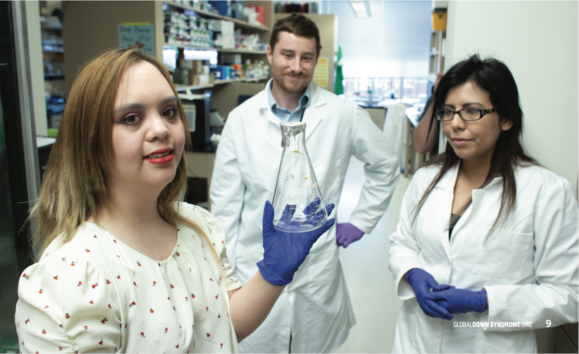
PUTTING TOGETHER ALL THE EVIDENCE:
#1 – People with Down syndrome have higher levels of interferon signaling.
#2 – Once infected, people with Down syndrome have an increased risk of experiencing a stronger cytokine storm and thus a more severe case of COVID-19.
#3 – Both during and after infection with SARS-CoV-2, people with Down syndrome will be more likely to also contract bacterial pneumonia.
It is important to note that these are hypotheses and predictions based on existing evidence outside of COVID-19 and should be taken into consideration with caution. The studies needed to fully understand COVID-19 in people with Down syndrome are still just starting to get underway. The good news is, there are people with Down syndrome, with and without underlying conditions, who are surviving COVID-19. We simply need more data and to better understand this virus before we can definitively come to conclusion.
HOW DOWN SYNDROME RESEARCH FROM THE CRNIC INSTITUTE IS BEING UTILIZED TO STUDY AND TREAT COVID-19
Since March, every member of Dr. Espinosa’s team, from the basic scientists to the clinical researchers, and even the administrators, have been utilizing their unique skills and knowledge gained while working in Down syndrome to rapidly advance COVID-19 research at CU.
For example, Crnic Institute scientists immediately started testing potential therapeutics for the COVID-19 cytokine storm in their mouse model of Down syndrome, nicknamed Dp16. They weren’t actually exposing the Dp16 mice to SARS-CoV-2; they didn’t need to. Instead, the scientists could activate the immune system and stimulate a cytokine storm much like what is seen in COVID-19, simply by using a molecule that tricks the immune system into sensing a virus when there isn’t one. Crnic scientists then treat the mice with JAK inhibitors targeting the interferon signaling pathway that is chronically activated in people with Down syndrome and that drives the cytokine storm in COVID-19. The data resulting from these experiments will be extremely valuable because it can be interpreted and utilized in two contexts: COVID-19 and Down syndrome.
FIGHTING COVID-19 TOGETHER
Who would have ever guessed that Down syndrome research and the discovery that interferon signaling is chronically activated in people with Down syndrome would one day so greatly impact the science and research behind a historic, global pandemic? This meaningful contribution to the body of science and medical practice surrounding COVID-19 is something the Down syndrome community should be proud to be part of. Together, this community of researchers, self-advocates, families, and supporters can clearly make positive scientific impacts not only for people with Down syndrome, but also for the entire world.
THE CRNIC INSTITUTE HUMAN TRISOME PROJECTTM IN ACTION AGAINST COVID-19
At the beginning of the quarantine, CU assembled a centralized team tasked with rapidly creating a biobank to collect blood and other biological samples from COVID-19 patients. These samples would then be administered to researchers with approved projects. This model essentially replicates one of the Crnic Institute’s flagship research initiatives, the Crnic Institute Human Trisome ProjectTM (HTP). The HTP is generating multiple layers of “omics” data (think big data from sequencing all of someone’s DNA and RNA and measuring all their proteins, metabolites, immune cells, and much more) on hundreds of people with and without Down syndrome in order to understand the hallmarks of and co-occurring medical conditions associated with Down syndrome. Having heard about the Crnic Institute’s HTP and Biobank, the CU COVID-19 team reached out to Crnic scientists to tap into their expertise. The Crnic team shared detailed protocols and helped advise the CU team during the development of the CU COVID-19 Biobank.
As part of a synergized endeavor with the COVID-19 Biobank, leading researchers at CU also partnered with Dr. Espinosa and the Crnic team to replicate the experimental platform from HTP and apply it to COVID-19. The parallel effort by CU to apply the HTP platform to COVID-19 has been aptly dubbed “The COVIDome Project,” and Crnic scientists are leading the ongoing data generation to advance COVID-19 research for better diagnostics and therapeutics.
The Crnic team is also partnering with a national COVID-19 collaborative group to specifically study COVID-19 in people with Down syndrome. As explained earlier in this article, so much is yet unknown about COVID-19 in Down syndrome and numerous studies are needed to understand its impacts. The team is working with top data scientists at CU to identify differences in risk factors, symptoms, clinical course, immunological parameters, response to various treatments, and outcomes and long-term effects of COVID-19 in people with Down syndrome. Alongside these efforts, the Crnic team is also studying individuals with Down syndrome who have recovered from a SARS-CoV-2 infection as part of the HTP, in order to assess changes induced by COVID-19 across all the layers of omics data. Together, Crnic scientists hope these efforts will advance our understanding of interferon signaling and the cytokine storm in COVID-19 and Down syndrome and
inform the development of customized preventative and therapeutic solutions.

Like this article? Join Global Down Syndrome Foundation’s Membership program today to receive 4 issues of the quarterly award-winning publication, plus access to 4 seasonal educational Webinar Series, and eligibility to apply for Global’s Employment and Educational Grants.
Register today at downsyndromeworld.org!
Global Down Syndrome Foundation Announces Eight Grant Winners At The National Ds Affiliates In Action Conference
February 28th, 2020 by Global Down Syndrome Foundation
Global grants fund a total of 80 jobs for people with Down syndrome in the US and Peru
At DSAIA Leadership Conference; Keynote speaker Zack Gottsagen and Global President & CEO Michelle Sie Whitten with awardees (L-R): Down Syndrome Association of Greater St. Louis, Down Syndrome of Louisville, Down Syndrome Association of Connecticut, Down Syndrome Association of West Michigan, Down Syndrome Association of Delaware (Not Pictured: Down Syndrome Association of Wisconsin, Down Syndrome Network Arizona, Sociedad Peruana de Sindrome Down)
Press Contacts:
Rejena Carmichael | rcarmichael@globaldownsyndrome.org | C: (240) 603-5494
Anca Call | acall@globaldownsyndrome.org | C: (720) 320-3832
Orlando, FL and DENVER, CO February 28, 2020 – Today, Global Down Syndrome Foundation (Global) announced eight new Global Self-Advocate Employment Initiative Grant winners at the national Down Syndrome Affiliates in Action (DSAIA) Annual Leadership Conference.
“We started this grant program in 2016 after attending a DSAIA conference and realized that many Down syndrome organizations cannot afford to employ people with the condition despite advocating for other companies to do so,” said Michelle Sie Whitten, President and CEO of Global. “To address that, we worked with our members on this grant program and we are proud to have supported 80 self-advocates jobs from 20 states and one in Peru! I’m so proud of our team and our members for making this all a reality in such a short time.”
The 2020 winners are: Down Syndrome Association of Connecticut, Down Syndrome Association of Delaware, Down Syndrome Association of Greater St. Louis, Down Syndrome Association of West Michigan, Down Syndrome Association of Wisconsin, Down Syndrome Network (AZ), Down Syndrome of Louisville, and Sociedad Peruana de Sindrome Down (Peru). This year’s Global Self-Advocate Employment Initiative Grants will underwrite self-advocate volunteers transitioning to paid contractors or staff, expansion of hours for self-advocate staff, work-place training, and public speaking training.
Past winners appreciate that Global’s grants can be multi-year, and that many grants have led to leveraged funding.
“Our organization is dedicated to helping our adults with Down syndrome develop vocational and professional skills. We have been fortunate to earn more than one of Global’s transformative employment grants, allowing us to train, prepare, and hire self-advocates for employment especially in our hospital clinic,” says Lauren Camp Gates, Executive Director of Down Syndrome Association of Delaware.
Erin Suelmann, Executive Director of Down Syndrome Association of Greater St. Louis agrees, “Global has helped us expand our ‘Ready to Work Employment Initiative’ programs. In 2018, Global’s grant empowered us to hire an Employment Assistant Ambassador and now we have on-going funding for that position. This year we are so grateful for another grant to grow our staff and hire a Peer Trainer for Social Enterprise.”
2020 grant winners received their award certificates from Whitten and DSAIA conference keynote speaker, Zack Gottsagen. Gottsagen, who starred in the award-winning hit indie film, The Peanut Butter Falcon, is an example of a hardworking individual with Down syndrome excelling in his career. Whitten is an executive producer of The Peanut Butter Falcon and led Global Members in marketing initiatives to ensure the film’s distribution success.
“I wanted to act from the time I was three,” said Gottsagen. “My mom listened to me so I took acting lessons for years. Then two acting coaches wrote a film for me to star in and I won awards for my acting at SXSW and Palm Springs Film Festivals. I showed up, worked hard, got this big break, and presented at the Oscars. It is important that parents and organizations have high expectations and provide training to children and adults with Down syndrome.”
Global membership benefits include supporting life-saving and transformative initiatives, Global’s award-winning magazine Down Syndrome WorldTM, Down syndrome expert webinars, and two first-in-kind grant programs – Global Membership Educational Grants and Global Membership Self-Advocate Employment Initiative Grants. To become a Global Down Syndrome Foundation member or to learn more about member benefits, visit: https://www.globaldownsyndrome.org/become-a-member/.
About Global Down Syndrome Foundation
The Global Down Syndrome Foundation (Global) is the largest non-profit in the U.S. working to save lives and dramatically improve health outcomes for people with Down syndrome. Global has donated more than $32 million to establish the first Down syndrome research institute supporting over 400 scientists and over 2,000 patients with Down syndrome from 28 states and 10 countries. Working closely with Congress and the National Institutes of Health, Global is the lead advocacy organization in the U.S. for Down syndrome research and care. Global has a membership of over 100 Down syndrome organizations worldwide, and is part of a network of Affiliates – the Crnic Institute for Down Syndrome, the Sie Center for Down Syndrome, and the University of Colorado Alzheimer’s and Cognition Center – all on the Anschutz Medical Campus.
Global’s widely-circulated medical publications include Global Medical Care Guidelines for Adults with Down Syndrome, Prenatal Testing and Information about Down Syndrome, and the award-winning magazine Down Syndrome WorldTM. Global also organizes the Be Beautiful Be Yourself Fashion Show, the largest Down syndrome fundraiser in the world. Visit globaldownsyndrome.org and follow us on social media (facebook & twitter:@GDSFoundation)(instagram:@globaldownsyndrome).


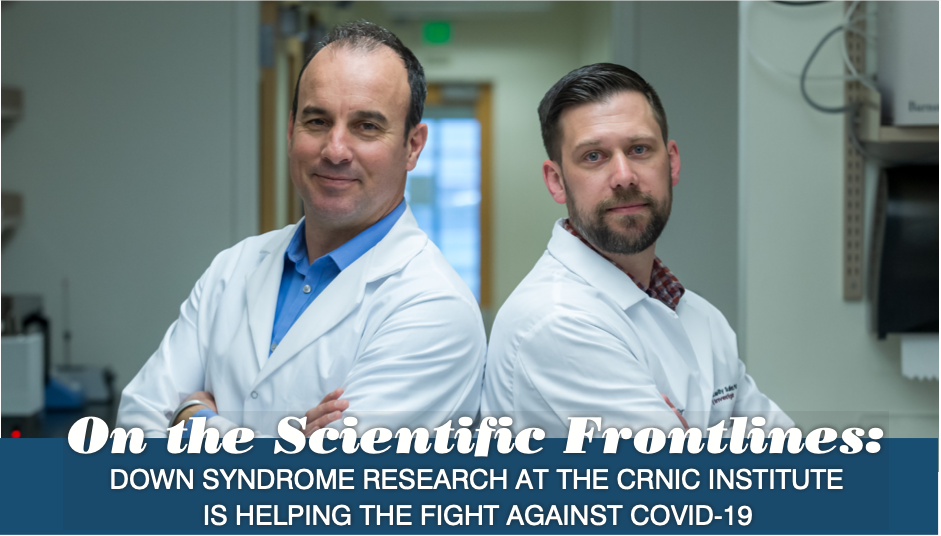
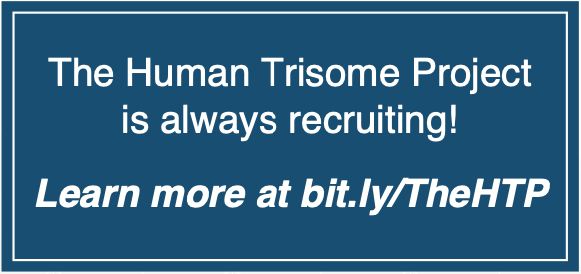
 Experience our inspirational and groundbreaking videos and photos. Our children and self-advocates are beautiful AND brilliant!
Experience our inspirational and groundbreaking videos and photos. Our children and self-advocates are beautiful AND brilliant! Make sure your local Representatives are on the Congressional Down Syndrome Task Force.
Make sure your local Representatives are on the Congressional Down Syndrome Task Force.